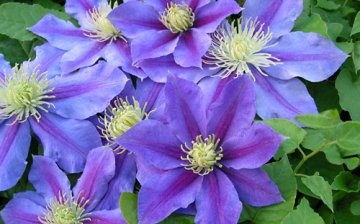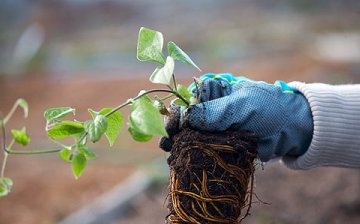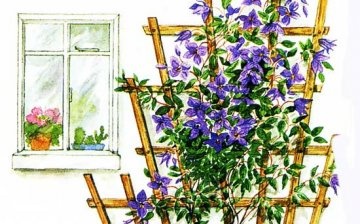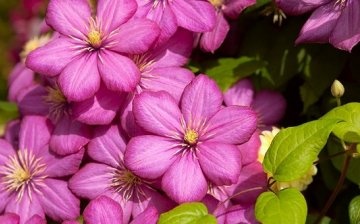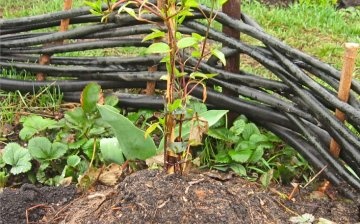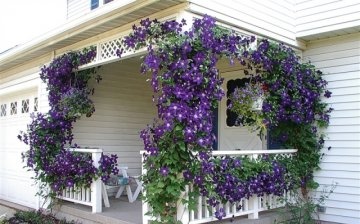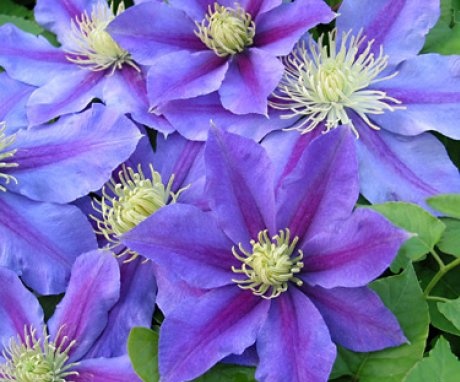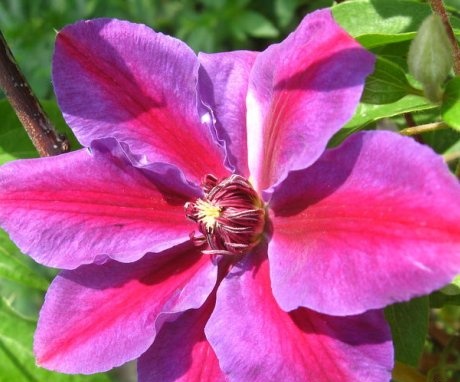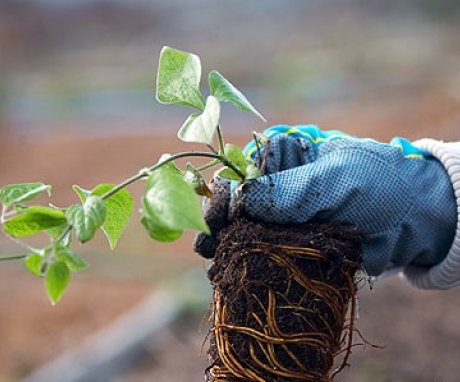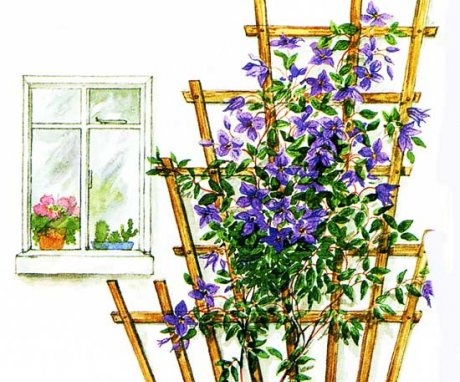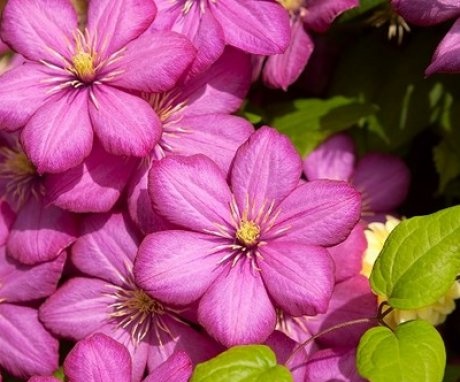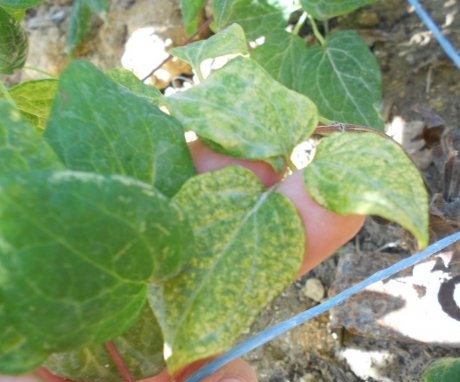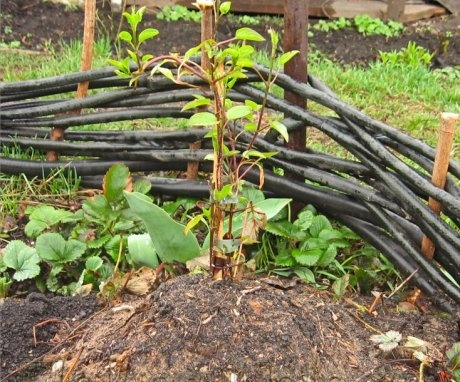Clematis - planting rules and tips for caring for a vine
Grow clematis in Europe began in the 16th century. At first, these flowers came to the territory of Russia as greenhouse flowers. Gradually, breeders began to develop winter-hardy varieties. Since the middle of the last century, a large number of winter-hardy varieties with beautiful flowers have appeared.
Content:
- Clematis: description
- Growing conditions
- Planting clematis
- Support for clematis
- Clematis care
- Diseases and pests of clematis
- Preparing clematis for winter
- Using clematis
Clematis: description
Clematis belongs to the buttercup family. Its name in translation from Greek means curly. Most of the species of this plant, in fact, twine around any support with the help of leaf stalks. The main popular name is clematis. In total, there are about 3 hundred types of clematis.
Clematis are herbaceous, dwarf shrubs and leaf-climbing vines.
Root system in most species it is fibrous. But there is also a pivotal one, like the Tangut and serrate-leaved. She doesn't like transplants. Shoots are thin, brown, 4-6-sided. The leaves grow in pairs, each with 3-5-7 leaflets. Flowers are most often collected in scutellum inflorescences.
There are panicles and semi-umbrellas. 4-8 sepals serve as petals. They can be of almost any color. There are varieties with double flowers. Their flowering period is up to 3 weeks, while the usual flowering period is 2 weeks. Fruits are achenes, collected in fluffy heads.
All clematis can be conditionally divided into groups according to the principle of flower formation:
- Zhakmana - branches reach 4 m. They are decorated with large blue, violet and purple flowers. They don't smell. Flower buds form only on young vines. Blooms for a long period.
- Viticella is a relatively low bush, up to 3.5 m. Young vines bloom. Flowers of pink shades, with a beautiful velvet tint.
- Lanuginoza - even lower, about 2 m. Shrub with thin branches. Light flowers are located on the whips of the last year.
- Patens are strong, long vines. Flowers reach 18 cm, different colors, are formed on last year's branches. There are varieties with double flowers.
- Florida - reaches a height of 3 m. Flowers are more often of light colors, located on old lashes.
- Integrifolia are semi-shrubs. They grow up to 1.5 m. The original flowers in the form of bells, reach a size of 12 cm, bloom on the shoots of this year.
Clematis varieties are divided according to the size of flowers. Large-flowered are considered to be exceeding 8 cm in diameter. Small-flowered - up to 8 cm. The small size of the flower does not mean that the plant is less decorative. Usually small-flowered clematis are very decorative, grow quickly, bloom for a long time (from 2 weeks to 4 months). Many of them have a pleasant aroma:
- Burning
- Straight
- Paniculate
- Armanda
- Clematis David
There are creeping clematis, the height of which does not exceed 8 cm (Marmoraria variety), undersized - up to 1 m, tall ones reaching 5 m and more.
Growing conditions
Clematis loves sunlight. In the shade, the number of flowers is significantly reduced. You can plant it in partially shaded areas.You should not grow clematis in drafts, where strong winds often blow. He will break and confuse his whips, pick flowers.
Clematis are demanding on soil moisture, as they do not tolerate drought well.
But waterlogging is even more destructive for them. If from a lack of moisture they lose their decorative properties, then the excess leads to decay of the plant roots. Therefore, they cannot be planted in places where groundwater approaches the soil surface at a distance of less than 1.2 m. If there are no other options, then the soil is drained by laying grooves to drain water.
The soil for cultivation should be nutrient-rich, loose, sandy or loamy, good air permeability. The reaction is slightly acidic, neutral or slightly alkaline. You can not plant clematis in lowlands and under roof slopes, where water constantly flows. It is necessary to retreat about a meter from the place where the water enters. With proper care, clematis grows in one place for up to 25 years.
Reproduces:
- By dividing the bush
- Layers
- Green cuttings
- Seeds (small-flowered varieties)
Planting clematis
Plants with an open root system are planted in April-May. Their kidneys begin to develop very early. Therefore, you need to plant before they grow. Otherwise, the plant may weaken and poorly survive the transplant. By planting clematis in the fall, they give it time for rooting. You can start planting in August. Usually planted in September take root. They are planted in the same way as in spring, but closer to winter they are insulated with covering materials.
Closed-root clematis (in special pots for transportation) can be planted outdoors all summer. They can wait for the appropriate weather if they were purchased too early.
Landing rules:
- To plant the plants, they dig a hole 60x60x60 cm in size. It is filled with specially prepared soil for further cultivation.
- The upper fertile layer is mixed with 2 buckets of humus, a bucket of sand. Add 200 g of complex mineral fertilizers... Analyzing the quality of the soil, they introduce bone meal or lime (for acidic), peat, clay.
- If more than one bush is planted in a row, then usually one hole is dug. Its bottom is covered with a drainage layer: brick, gravel, expanded clay. The distance between the bushes should be at least 1 m.
- Then the prepared soil is poured so that it fills the hole to half. A mound is formed from above.
- The seedling is immersed in the hole. Smooth the roots down so that they are directed in all directions from the mound evenly.
- Gently sprinkle with soil, lightly compacting it with your hands.
- The root collar is sprinkled with sand, which will protect it from decay.
- Water abundantly. When the water is absorbed into the soil, it is loosened.
- The soil around the planted bushes mulch thick layer of grass, which is constantly replenished.
You can plant annuals near the bushes, which will protect the root from overheating in summer. The immersion depth of a seedling depends on its age and size. Two-year-olds and one-year jigs are immersed by 10 cm, older plants - by 20 cm. But in order to subsequently form a powerful bush, several buds are also immersed, from which young shoots will form.
Support for clematis
Support is of great importance for creating a beautiful bush. It must be strong, because in a few years it will have to hold a large bush. You can install it immediately or use a temporary one. But such supports are justified only for bushes, in which flowers are formed on young lashes. After flowering they are cut short, and it becomes possible to replace the support.
For varieties blooming on last year's stems, it will be correct to establish a constant. After all, the stems of clematis so firmly cover everything that comes across to them along the way that it can be very difficult to separate them.
When installing the support, take into account that it must be beautiful, the size corresponding to the size of the ground part of the bush.
Then the plant will be able to show its best side. With a small support, it will look like a cocoon with flowers that have strayed to one side. The support frame is best made of metal. And as guides, you can take wire, ropes. It is better to tie up the lignified parts of the stems. When placing young vines, take into account that more flowers grow on horizontal ones.
Clematis care
Clematis are quite unpretentious plants. In dry weather, they are watered. Water is not poured onto the root, but it is made sure that it spreads around the bush, under the mulch. It is better to use warm water. 1-2 buckets are poured under one young bush at a time, up to 4 buckets under an adult.
The soil after watering, if it is not covered with mulch, is loosened and removed weeds.
Almost all clematis are sent to supports only until the time when they themselves begin to do this. Scourges are tied up to show them the direction. The varieties of the Intergrifolia group are tied up constantly, because they do not have antennae that allow them to catch on to the support. Having planted a new clematis, the gardener dreams of seeing it bloom as soon as possible. But there is no need to rush. If flower buds are set in the year of planting, they should be removed without regret. This will allow the root to grow stronger.
Sometimes a young clematis has only one stem. To form lateral shoots faster, pinch the top of the central one. This can be repeated several times during the season with all the shoots.
Top dressing of clematis:
- In order for clematis to bloom as long and magnificently as possible, its bushes need to be regularly feedstarting at 2 years of age.
- Once a month you need to pour them with a solution. chicken droppings or mullein... On a bucket of water take 1 liter of solution, which was previously fermented for 10 days.
- You can use a comprehensive mineral fertilizer... It is better to use alternately different types of fertilizers.
- Fertilizers are not applied only during the flowering period. In August, they stop adding nitrogen.
- Once every 4 weeks, watered with boric acid or potassium permanganate.
- Foliar top dressing of clematis is carried out by spraying with a urea solution.
- For the 2-3rd year, liquid feeding is carried out 2 times a month.
- At the beginning or end of the growing season, a bucket of humus mixed in a handful of wood ash is introduced under the bush.
Diseases and pests of clematis
Plants are susceptible to gray mold disease, powdery mildew... In the cloudy cold summer, clematis leaves can suffer from the fungal disease of septoria. A dark heel may appear on the leaves, inside which a gray center forms. So that the disease does not interfere with the development of the plant, they process it fungicides.
You can treat the soil before planting plants with a solution of foundationol (0.1%). The soil under the previously planted plants is treated, starting from the budding period, several times. About 3 liters of solution are used per bush.
A dangerous disease of clematis is infection nematode... This small worm infects various parts of the plant. Damage to the root system is especially dangerous. Most often, it leads to the death of the entire plant. The first signs of damage by leaf nematodes are a change in the shape of the leaves. They become ugly, thickened in some places. Then dark spots appear with a gray center.
To scare off pests near clematis bushes are planted marigold, mint, garlic.
When damaged by root nematodes, the shape of the roots also changes, thickenings-galls appear on them. Nematodes destroy the root vessels that the plant feeds on. As a result, the roots die off. But their destruction is more difficult to see than leaf damage. When the signs of damage to the plant become obvious, it is usually impossible to save it. Fighting a nematode is very difficult. Its eggs remain in the ground for many years. You can destroy them by removing all affected roots from the site.Then you need to thoroughly steam the soil. It is difficult to do this at home. Each portion of the soil needs to be steamed for about an hour.
Therefore, you need to very carefully monitor all plants that fall on the site. At the slightest suspicion of nematode infection, they must be removed. Plant roots must be healthy and of the correct shape. Diseases can be prevented by observing the temperature regime of the soil around the root system. If it does not rise above 15 degrees, then the nematode does not develop. Therefore, it is mulched with peat. When fresh manure is used, the soil temperature rises, which contributes to the rapid reproduction of nematodes.
Preparing clematis for winter
Clematis is a fairly frost-resistant plant. They are able to survive at temperatures of -45 °. Waterlogging of the soil or night frosts can destroy them. At this time, moisture that fell on the center of tillering during the day freezes, expands and can break it.
Therefore, the main task in preparing for winter is to isolate the base of the bush from moisture.
In the fall, the bush is cut off, the leaves are removed from the remaining part. Pruning is carried out in different ways for different groups of clematis. Everything clematis are conventionally divided into groups according to the cutting method. But in fact, the plants in these groups differ in the way they form flowers:
- In the first group, they are located on young shoots. Those of them that lay flower buds on young shoots are pruned low, leaving several pairs of buds on each stem. Can be cut at ground level. These are representatives of the Viticella, Zhakman, Integrifolia groups. The bushes prepared in this way are sprinkled with dry earth or peat. Pour 3 buckets on each bush. The soil will freeze, covered with snow, and a mound of earth will protect the roots from moisture. Wintering preparation is carried out as late as possible, when the soil begins to freeze and the outside temperature drops to -5 °.
- In the second, first on last year's, closer to autumn - on the young. Clematis of the second group are cut no higher than a meter from the ground. In the summer, after last year's branches have faded, they are pruned.
- In the third group - only on last year's vines. Plants of the Patens, Florida, Lanuginoza groups are lightly pruned, removing only the part of the vine on which the flowers were. Indeed, next year, it is on these lashes that there will be flower buds. Therefore, first they build a mound of earth or peat. The rest of the lashes are carefully folded, laid on the ground. Cover with improvised materials: boards, spruce branches, roofing material. In winter, they make sure that this shelter is constantly under the snow. In the spring, they first remove the shelter from the branches, and after the establishment of dry and warm weather, I remove the soil and peat.
Using clematis
Clematis used for landscaping gardens, parks, buildings. A wide range of colors and flowering periods allows you to create a flowering conveyor from late summer to frost. The earliest ones begin to bloom from the end of May. Late - in September. In order to choose the correct sequence of varieties, use the concept of a coefficient flowering... The higher it is, the more flowers the bush will form. At the same time, the flowering part is located lower, closer to the ground.
Clematis is used both as a dominant in the garden and with other plants.
They are used to decorate gazebos, buildings, columns. With their help, you can create a background of the desired color. Groups are created from the clematis themselves, or combined with other plants: roses, rhododendrons.
For planting in single plantings, the most beautiful and long-flowering varieties with a high flowering rate are used. This is:
- Margot Costel
- Carmencita
- Madame Herouard André
- Non-dynamism
- Victoria
Create hedges, backstage. For them, wind-resistant varieties are used. Use clematis to create rock gardens. For this, varieties are planted that grow without support and spread along the ground.
More information can be found in the video:




